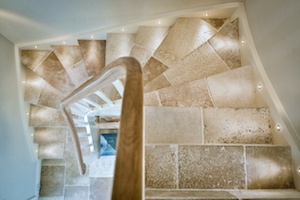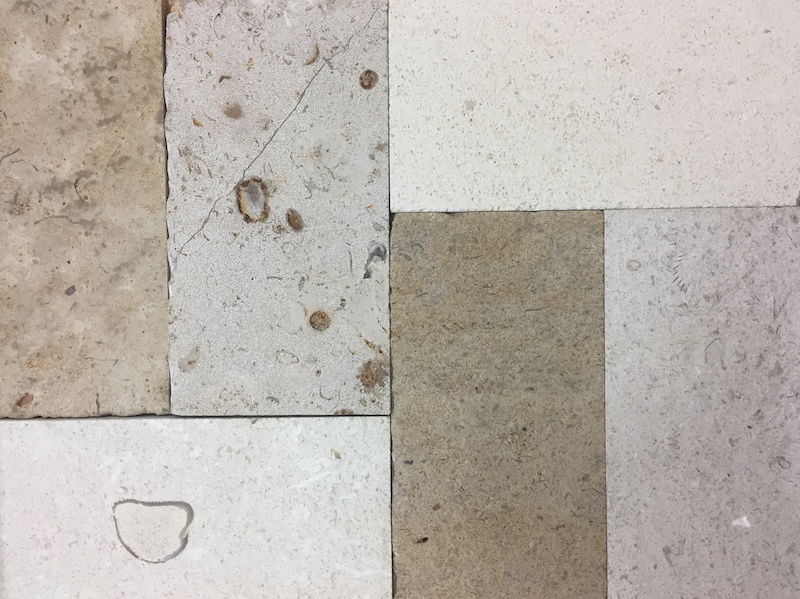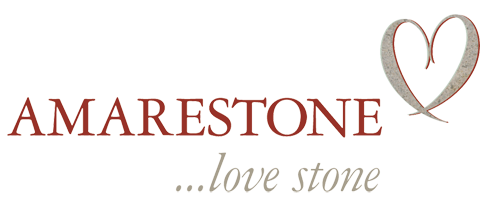Capture the look of an ancient floor with French Limestone
We are occasionally asked to supply limestone flooring that looks like it could have been laid centuries ago. Clients love the look of a well-worn stone floor and they want to recreate the look in their new or refurbished homes. How can this be achieved?
Firstly, we can use stone that has been reclaimed from an ancient building. Limestone flooring can be dug up from disused old buildings but the stone can be difficult to lift or could be damaged in the process of removal. Using reclaimed old stone can be one way of instantly getting the aged look but it is labour intensive and the supply may not meet the demand. As a result, the price can be astronomically high.
The second option is simpler and far more cost effective.
On my latest trip to the quarries in south west France, I was shown how a variety of different ageing processes can be applied to new limestone tiles to re-create the look of an old stone floor.
Vieux Monde French Limestone - creating the appearance of reclaimed limestone
The Vieux Monde limestone (above) is a mix of complementary different stones from a few Burgundy quarries in France. Before the advent of modern electric power tools, the stone would have been hand-finished by the stone masons. A collection of stone reclaimed from various buildings would probably show a range of hand-crafted techniques that would have been characteristic of different regions from centuries ago.
 What sets the Vieux Monde apart from other "antiqued" modern-day stone flooring is the range of surface finishes that is applied to the limestone. Some tiles are tumbled, some are bush-hammered and some are given chipped edges. Tile sizes are cut to random lengths and usually in two or three different widths to create the look of ancient stone flooring.
What sets the Vieux Monde apart from other "antiqued" modern-day stone flooring is the range of surface finishes that is applied to the limestone. Some tiles are tumbled, some are bush-hammered and some are given chipped edges. Tile sizes are cut to random lengths and usually in two or three different widths to create the look of ancient stone flooring.
The idea of using stone from several different quarries is quite commonly used when recreating the appearance of an old floor. The variety of textures and colours can be very appealing. If the stones are all processed by the same factory, then the calibration should be similar across the entire batch which avoids problems when it comes to the installation. Very often, genuine reclaimed stone will be a mixture of different thicknesses which can cause issues for the installer.
The image below shows a different range of French limestones offered by another of our partner quarries where all the stone would be processed in the same factory. Clients can select which stones to include in the mix and what the surface texture should be for each of them. They can also specify the tile sizes and layout pattern to create a truly unique floor.
 A selection of French limestone to create the look of reclaimed limestone
A selection of French limestone to create the look of reclaimed limestone
There is a huge range of options for creating the appearance of an aged or reclaimed floor. Most of the quarries have equipment that can apply some sort of textured surface to the stone to give it a well-worn look to recreate the appearance of an ancient floor.
See more of our French limestone here (link opens in a new window).
If you have a project coming up where you want to use reclaimed stone or you want the look of reclaimed stone flooring, then call or email to discuss the choices.
Alternatively, fill in the form below and tell us a little about your project in the comments box.
Our brochure explains how we can help you make the right choice.
Thanks for reading.
Steve Turner
Amarestone
Tel: 0345 260 8070
P.S. - get the next blog direct to your inbox by entering your email address in the box on this page.



